Academic dress

| Part of a series on |
| Western dress codes and corresponding attires |
|---|
|
Legend: |

Academic dress is a traditional form of clothing for academic settings, mainly tertiary (and sometimes secondary) education, worn mainly by those who have obtained a university degree (or similar), or hold a status that entitles them to assume them (e.g., undergraduate students at certain old universities).[1] It is also known as academical dress,[2] academicals, subfusc and, in the United States, as academic regalia.
Contemporarily, it is commonly seen only at graduation ceremonies, but formerly academic dress was, and to a lesser degree in many ancient universities still is, worn daily. Today, the ensembles are distinctive in some way to each institution, and generally consist of a gown (also known as a robe) with a separate hood, and usually a cap (generally either a square academic cap, a tam, or a bonnet). Academic dress is also worn by members of certain learned societies and institutions as official dress.[3][4]
Overview[]
The academic dress found in most universities in the Commonwealth of Nations and the United States is derived from that of the universities of Oxford and Cambridge, which was a development of academic and clerical dress common throughout the medieval universities of Europe.[5]
Formal or sober clothing is typically worn beneath the gown so, for example, men would often wear a dark suit with a white shirt and a tie, or clerical clothing, military or civil uniform, or national dress, and women would wear equivalent attire. Some older universities, particularly Oxford and Cambridge, have a prescribed set of dress (known as subfusc) to be worn under the gown. Although some universities are relaxed about what people wear under their gowns, it is nevertheless considered bad form to be in casual wear or the like during graduation ceremonies, and a number of universities may bar finishing students from joining the procession or the ceremony itself if not appropriately dressed[6] (though this sometimes refers only to requiring the proper wear of academic dress and not what is worn beneath it, if unseen). In the Commonwealth, gowns are worn open, while in the United States, with a few exceptions, it has become common for gowns to close at the front, as did the original roba.
Materials[]
In general, the materials used for academic dress are heavily influenced by the climate where the academic institution is located, or the climate where the graduate will usually be wearing the costume (as a faculty member at another institution, for example). In either case, the American Council of Education (ACE) allows for the comfort of the wearer, and concedes that lighter materials be used in tropical climates, and heavier materials elsewhere.[7] In addition, it acknowledges cotton poplin, broadcloth, rayon, or silk as appropriate.[8]
The materials used for academic dress vary and range from the extremely economical to the very expensive. In the United States, most Bachelor and master's degree candidates are often only presented the "souvenir" version of regalia by their institutions or authorized vendor, which are generally intended for very few wearings and are comparatively very inexpensive. For some doctoral graduates, commencement will be the only time they wear academic regalia, and so they rent their gowns instead of buying them. These rented (or hired)[9] gowns are often made of inexpensive polyester or other man-made synthetic fibre. In Britain, rented gowns are almost always polyester while Russell cord, silk, or artificial silk gowns are only available when bought. Undergraduate gowns are usually made from cotton or cotton and polyester mix and are relatively inexpensive to encourage students to own them.
People who choose to buy their dress may opt for finer fabrics, such as poplin, grosgrain, percale, cotton, wool, cassimere, broadcloth, Russell cord, or corded/ribbed material. For silk, there are a range of types including artificial silk/rayon, Ottoman (i.e. ribbed or corded silk), taffeta, satin, alpaca, true silk, shot silk, or a mixture. Pure Ottoman silk is rarely used except for official gowns, as it is very expensive.[10] Some gowns may be trimmed with gimp lace, cords, buttons, or other forms of decoration.
In the past, fur has been used to line certain hoods (especially those of the UK) which range from rabbit to ermine. In the past, sheepskin was widely used. Most now use imitation fur, instead, mainly because of cost and animal rights concerns. Some robe makers use fur if the customer requests and pays for it, as some feel that the quality and feel of artificial fur has yet to match that of real fur.[11]
Doctor's robes usually use wool flannel, (worsted), superfine cloth, damask, or brocade, and are brightly coloured (or black, but faced with a bright colour) to distinguish them from lower degrees. They tend to be the most expensive because they must be dyed in a specific colour and/or be trimmed in coloured silks. Many doctoral gowns have a special undress version so adding to the cost of a full set.
A full set may cost about US$360 (£180) for cheap materials to as much as $5800 (£2900) for high-quality materials.[12] Usually, ex-hire gowns are available for purchase at cheaper prices, though the quality may be lower.[13]
Many institutions whose dress includes gowns of varying lengths prescribe the appropriate length of each gown with reference to parts of the wearer's body (undergraduate gowns at Cambridge, for example, must not reach the knees, whereas BA gowns should reach just beyond them, according to the University's statutes). As such, suppliers of academic dress produce gowns in many different sizes to fit persons of different heights.
By country or district[]
Canada[]
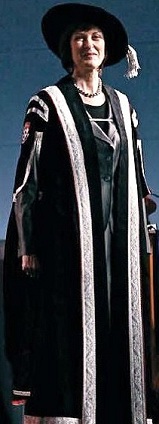
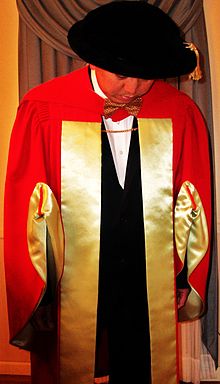
In Canada, academic regalia are worn by university officials, faculty, students, and honoured guests during Graduation exercises (commonly referred to as Convocation), installations of their presiding officers, and special convocations, such as the inauguration of newly endowed professorial chairs and inductions to some of the honour and professional societies with university chapters. Academic regalia typically consist of a headgear (mortarboard, Tudor bonnet, or ), robe, and hood. Until the 1930s, Canadian universities customarily prescribed academic robes for its professors and students at classes and lectures. At the University of Trinity College at the University of Toronto, academic gowns are still required for all students and faculty at Wednesday dinners, most college meetings, debates, and certain special college events.[14]
Most Canadian universities follow or adopted either the British University academic dress at Oxford or Cambridge universities,[15][16] or the Intercollegiate Code of Academic Costume ratified by most American universities in the late 1890s.[17] Other universities contain elements of the British and American patterns for some or all of their academic costumes. A classic example is the academic dress of McGill University, whose British origins are evident in the regalia of its degree holders. The distinctive ceremonial regalia of McGill University officials, though, are closer to the American pattern for the master's robe with above-the-elbow, square, slit-cut sleeves. The scarlet, doctor of philosophy (PhD) regalia of McGill can now be worn closed-front, unlike the open-front only gown of the University of Cambridge higher doctoral full dress, from which it evolved. Gold strand tassels used in American doctoral regalia are wrapped around McGill's otherwise Tudor-style bonnet or tam.
France[]

In France, academic dress, also called the toge (from the word toga, an ancient Roman garment), is similar to French judges' court dress, except for its colour, which depends on the academic field in which the wearer graduated. It is nowadays little worn, except by doctors during the opening of the university year or the ceremony for a doctorate honoris causa. For doctors, it consists of:
- A long gown (a bit similar to a cassock) with a long row of buttons (traditionally, 33, but nowadays usually fewer) in front and a train at the back (which in the current costume is not visible but attached with a button in the inner side of the gown). The gown is in two colours: black and the standard colour of the academic field in which the wearer graduated (see below), with simars (two vertical bands in the front of the gown).
- An épitoge (epitoga): A piece of cloth with white fur stripes (three for doctors) attached by a button on the left shoulder, with a rectangular, long, thin tail in the front and a triangular, shorter, broad tail in the back (both tails carry the fur stripes); its colour is that of the relevant academic field. The epitoga has evolved from the academic hood, which explains why the French academic dress does not include a hood.
- A long, wide belt or sash, either black or of the colour of the relevant academic field, ended by fringes (which may be golden or of the same colour as the belt), and attached with a broad, ornamental knot.
- A white rabat (jabot), over which a white tie may be worn for ceremonial occasions: It is made of lace for the Dean of the Faculty, the President of the University, and a few other officials, of plain cotton for others.
- Traditionally only for men, a mortarboard of the colour of the relevant academic field with a golden stripe, which is usually not worn but carried (since the academic dress in France is rarely worn outdoors, and men are not supposed to wear hats indoors), and often even omitted. Nowadays the practice is more relaxed, and the mortarboard is sometimes seen worn by women or worn indoor by men.
- In principle, a white bow tie (for men only ; quite rarely seen) and white gloves (nowadays never used).
Professors who served 20 years are sometimes presented with a sword (identical model to that of French police commissars).
The colours of the various academic fields are daffodil (yellow) for literature and arts, amaranth (purplish red) for science, redcurrant (reddish pink) for medicine, scarlet red for law, and violet (purple) for theology. University rectors, chancellors or presidents wear also specific costumes, which are violet regardless of the academic field in which they graduated.
| Field of graduation | Colour name | Colour aspect |
|---|---|---|
| Divinity (and all high officials regardless of the field) | Violet (Purple, specifically the Royal Purple shade) | |
| Law (colour also worn by high magistrates) | Écarlate (Scarlet) | |
| Medicine (and health-related fields) | Groseille (Redcurrant, a reddish shade of pink) | |
| Science (exact and experimental) | Amaranthe (Amaranth) | |
| Arts, literature, philosophy, humanities | Jonquille (Daffodil, a shade of yellow) |
The dress exists in two versions: the petit costume ("small costume") and the grand costume ("great costume"). Both are identical in form, and differ only in the presence or absence of the mortarboard and the repartition of colours on the gown and sash (the other elements of the dress, especially the epitoga, being identical for both):
- for the petit costume, the gown is all black, except the simarras which are of the colour of the academic field; the buttons are black; the sash and its fringes moiré black; the mortarboard is usually not worn;
- for the grand costume, the gown is black between the simarras, which are moiré black, and of the colour of the academic field on the sides and on the sleeves, except their turn-ups, which are black; the buttons are of the colour of the academic field; the sash is of the colour of the academic field, its fringes may be either the same colour or gold.
In formal occasions, the grand costume is equivalent to white tie, whereas the petit costume is equivalent to black tie.
Germany[]

German academic dress generally consists of gown and cap. Nowadays, if in use at all, it is only found at special occasions, such as public processions, inaugurations of rectors, and graduation ceremonies. Historically, only the rectors, deans, professors, and lecturers wore academic dress—not students or graduates. Each German university had its own system of colours and drapings to signify faculty membership and position in the university hierarchy.
The gown of the German academic dress is called "Talar" (with the accent on the second "a": talár; from Latin talare which means to the ankles). It can be traced back to the every day clothes of the scholars in the Middle Ages. The same word Talar is also used for the robes of Protestant (Lutheran) pastors and rabbis (not for judges or lawyers, their gowns are called "Robe"), although these gowns often differ more or less in cut, length, drapings, and sometimes even in colour (the gowns of the German Supreme Court are, e.g., completely dark red).
The professorial Talar can be described as a long black gown with wide sleeves, often with lapels in faculty colour, while deans wear a Talar completely in faculty colour. Rectors typically have a distinguished, more elaborate Talar, e.g., made of velvet, coloured in red, or with gold embroidery.[18][19] At some universities, the rector additionally wears a chain of office and, at some occasions, carries a scepter.[20][21] The cap that accompanies the Talar is called Barett. As is the case with the Talar, which type of cap is used varies by university as well. Historically, caps made of soft materials rather than the square academic cap are common. The colour of the Barett matches the Talar.[19]
After the German student movement, following the years of 1967 all West German universities dropped their academic dress because they were identified with right-winged conservatism and reactionism by the partly socialist influenced students at that time: The famous slogan "Unter den Talaren – Muff von 1000 Jahren" (beneath the gowns the fug of 1000 years) refers not to the old traditions of the Middle Ages, but especially to the Nazi regime and their self-declared "empire of 1000 years".[22] In East Germany, which was a communist one-party state, Talare were abolished by law at about the same time. After East Germany began to dissolve in 1989, several universities, particularly University of Rostock,[23] University of Greifswald,[24] University of Jena,[25] and University of Halle-Wittenberg,[26] resurrected lost traditions including the Talar for officials. Some traditional universities in West German states have since followed, such as University of Heidelberg.[27]
Since 2005, some universities introduced centrally organized graduation ceremonies for students of all faculties where academic dress is worn, most notably University of Bonn,[28] Chemnitz University of Technology,[29] and RWTH Aachen (only cap and stole).[30] The graduates' dress usually consists of a simple black gown, a square academic cap, and possibly a stole in faculty colour. At most other universities, faculties are responsible for organizing graduation ceremonies individually. Some faculties have decided for wearing academic dress at their ceremonies as well, e.g., the Faculty of Law at University of Marburg[31] and the Faculty of Economics and Business Administration at Goethe University Frankfurt.[32] This practice is commonly understood as following Anglo-American examples rather than reviving old traditions.
Indonesia[]
This section needs additional citations for verification. (November 2017) |

In Indonesia, academic regalia, also called a toga is only worn in graduation ceremonies. An Indonesian toga generally comes in three pieces of clothing: a gown, a cape or a hood, and a cap with tassel (pentagon-shaped mortarboard/bonnet). Other items are also worn during graduation ceremony such as a medallion, tippet or academic stole.
There are four elements in Indonesian academic regalia:
- Gown – Indonesian academic gowns commonly come in black with a different color of trimming according to the field of study/faculty. In general they are long gowns with bell sleeves. There are some distinctive differences for each academic degree: for example, the length of undergraduate gown is usually below knee; for master's degrees, the gown is longer than undergraduate; and for doctoral degrees, the gown has a velvet panel (or velour for fabric substitution) on the front and sleeve.
- Cape or Hood – In most universities capes are commonly used for undergraduates/bachelor's degree students, meanwhile hoods are commonly used for graduate students (master/doctoral) and academic staff. A cape/hood is also colour-coded according to the field of study/faculty.
- Cap – For undergraduate and master's degrees a mortarboard is worn. Unlike most academic caps, which are square in shape, the Indonesian cap is usually pentagonal. Another type of cap like Tudor bonnet is generally worn by doctoral students, although in some universities like Padjadjaran University[33] the bonnet is worn for all academic degrees.
- Tassel – In most universities, before the commencement ceremony, undergraduates' tassel are placed on the left position, and during the graduation procession students receive their degree scroll/diploma and then move their tassel to the right. Tassels are also color-coded.
Italy[]
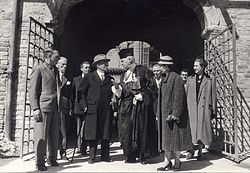
In Italy there are several differences among the typical academic dress (gowns, academic caps, etc.) of the different universities, due to the great number of ancient universities in the country (for example the University of Bologna,[34][35] University of Pavia,[36][37] University of Padua,[38][39][40] University of Pisa,[41] University of Siena,[42] University of Florence,[43] University of Rome,[44] etc.). Usually gowns are worn only by professors during ceremonies and, in some faculties, during graduations. After the student protests of 1968 many professors in many universities had stopped wearing academical gowns also in the formal occasions but since the 1990s people have started to use them again, mostly in humanities faculties.[45][46] Furthermore, also students have started to wear gowns and cap in graduation ceremonies (usually for PhD) in some universities.[38][46][47][48] Gowns are traditionally all hemmed with the colours of faculty, which have some variations following the tradition of each atheneum.[49] However the most widely used table of colours is the following[50]
| Faculty | Colour | Sample |
|---|---|---|
| Humanities | White | |
| Architecture and Engineering | Black | |
| Economics | Yellow | |
| Law | Blue | |
| Pharmacy | Maroon | |
| Political science | Lilac | |
| Education | Pink | |
| Medicine and Surgery | Red | |
| Veterinary medicine | Violet | |
| Natural science | Green | |
| Psychology | Grey | |
| Sociology | Orange |
Malaysia[]
In Malaysia, most public university academic gowns incorporate Songket motifs.
Netherlands[]
At Dutch universities, academic dress does not come with a degree but with the incumbency of a professorial chair: only full, chaired professors wear the toga with bib and beret. The beret is usually a soft cap, square or round and made of velvet; the gown (ankle-length, open in the front), is made of wool trimmed with velvet or silk It is traditionally black, as in the robes of early-modern humanists; some universities have gowns with wide slashed sleeves edged in faculty-specific colours, others have a decorated sleeve but without specific faculty colours. Recently established universities may show a greater variety of colours.
Academic dress is only worn on ceremonial occasions: the university anniversary or dies natalis, inaugural lectures, and the public defence of a doctoral thesis. On such occasions, the assembled professors line up as a cortège headed by the university beadle, who also wears an academic gown and carries the university's mace. Male professors remove their beret when sitting down and put it on when standing up (e.g. to lecture or to address a doctoral candidate during the thesis defence). Female professors may keep the beret on at all times.
Academic dress may be completed by a chain of office (for the presiding Rector or Dean) or the insignia of honorary doctorates or royal orders (only worn at the dies natalis).
New Zealand[]
University graduates in New Zealand wear an academic gown identical to those of the University of Cambridge[51] and either a hood or scarf, depending on whether the graduate is receiving a degree or diploma. If the graduate is receiving a degree, a hood[51] will be worn throughout the ceremony. If a diploma is received, the graduate will wear a diploma scarf.[52]
The hood, like the gown, is identical to that of the hood for the Cambridge Master of Arts. A Bachelor's degree hood is lined with coloured satin and bordered with white fur (the exception to this are Canterbury and Waikato University which do not line their hoods with fur). The bachelor's degree with Honours hood is lined with coloured satin and bordered with white satin. The master's degree hood has no edging. A doctoral degree recipient wears the same as a graduate receiving a Masters, except the gown is completely silk, either black or scarlet, with the option to wear a cloth gown. A Doctoral hood is completely silk and the headdress is a black Tudor bonnet, in place of the flat-topped mortarboard worn with Bachelor's and Master's gowns.
Academic dress is rarely worn in New Zealand other than at formal academic events, such as by graduates and faculty at graduation ceremonies and teaching faculty at school prizegivings. Some traditional boys' high schools retain the tradition of the headmaster wearing a gown while leading assemblies. Undergraduates who live at College House at the University of Canterbury must wear academic dress to dinner.
It is common for graduands to wear clothing or adornments significant to their culture at their graduation ceremony. For example, it is common to see Māori students wearing a traditional cloak known as korowai or kakahu huruhuru or Pasifika students wearing lavalava, ta'ovala and elaborate lei.
Below is a list of the general hood colours of graduates:
| Faculty | Colour | Sample |
|---|---|---|
| Architecture | Lemon | |
| Arts | Pink | |
| BBIM | Apricot | |
| Business Administration, MBA | Burgundy | |
| Commerce | Orange | |
| Dentistry | Violet | |
| Economics | Copper | |
| Education | Emerald,[51] Coral[53] | |
| Engineering | Dark Violet | |
| Fine Arts | Gold | |
| Human Biology | Crimson | |
| Law | Light Blue | |
| Medicine | Lilac | |
| Music | White | |
| Nursing | Navy | |
| Optometry | Blue Green | |
| Performing Arts | Pink | |
| Pharmacy | Grey Green | |
| Philosophy | Dark Blue | |
| Physical Education | ||
| Planning | Green | |
| Property | Silver | |
| Science | Dark Blue | |
| Theology, Divinity | Forest Green, Violet Grey |
Philippines[]
Most colleges and universities in the Philippines follows the traditional mortarboard, hood and gown during graduation.
In some schools of the country, the colour of the gown corresponds to the school colour (Blue for Colegio de San Juan de Letran and Ateneo de Manila University, Green for Far Eastern University, and Red for San Beda University).
Some schools, like the University of Santo Tomas, due to their Spanish heritage, follow Spanish academic attire such as the academic biretta and mozetta. The birreta and mozetta are worn by those from the Graduate School and the Faculty of Medicine and Surgery. Graduates of the Bachelors' programs wear the traditional mortarboard, hood and gown. The professors of the University wear their academic regalia during the Missa de Apertura or the Opening Mass of the Academic Year aside from Solemn Investitures (graduation ceremonies) and other academic activities. The academic colours are unique to this university as these depend on the official color of the faculty or college a student or an academe belongs into.
A unique graduation garb worn at member universities of the University of the Philippines System is the use of the Sablay. The Sablay was inspired from the Malong of Muslim Mindanao thus, giving it a Filipiniana look. It features the indigenous baybayin characters for "U" and "P".[54] During the commencement ceremony, graduates wear the Sablay at the right shoulder, it is then moved to the left shoulder after the President of the University confers their degree, "similar to the moving of the tassel of the academic cap." The Sablay is worn over traditional Filipino attire – Barong Tagalog for men and Filipiniana dress for women. The garb was first worn at the University of the Philippines Diliman. Other UP campuses followed suit.
Elementary and high school students also wear a certain kind of academic dress upon their graduation, usually a white gown and mortarboard for public schools. For private schools, the gown and mortarboard's color is at the discretion of the administration. There are several schools which make use of a hood-like design on top of their gowns which bears the school colors.
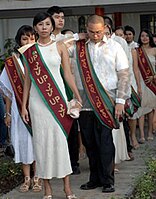
UP Diliman graduates preparing for the march

UP Diliman graduation ceremonies
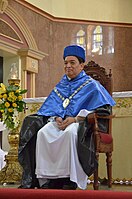
The Rector Magnificus of the University of Santo Tomas in Manila, Philippines, in full Spanish academic attire, wearing the academic biretta and the mozetta over the Dominican habit
Poland[]
The wearing of traditional academic dress is an important feature of Polish educational ceremonies.
Portugal[]
Academic dress varies from university to university. In some situations the hat is not used, e.g. Doctoral Exam.
In Portugal, following an ancient tradition, university regular students also use a specific dressing. The "Traje Académico", as it is known in Portuguese, is recognized by its almost totally black color and cape.
Singapore[]
 Academic dress for PhD in Singapore with description |
 Academic dress for Masters in Singapore with description |
Taiwan[]
Taiwan academic dress generally consists of gown and cap. Academic dress varies from university to university.
Nowadays, it is only found at special occasions, such as graduation ceremonies.
South Africa[]
Academic dress in South Africa varies from one institution to another, but generally follow UK patterns. A common distinction is for graduands in all degrees up to and including the master's degree to have black gowns, while the PhD candidate wears a scarlet gown. These days, academic dress is only used at graduation ceremonies. The wearing of traditional African attire, or modern clothes inspired by traditional attire, beneath the academic dress has been a distinct trend in recent years.
Spain[]
This article is partially translated from es:Indumentaria académica hispánica

The typical Spanish academic dress has Latin origin. It has been regulated since 1850, when Queen Isabella II established several rules about academic dress, according to the centuries-old Spanish custom. The typical Spanish academic dress for doctors is composed by:
- A black long gown (toga) with a long row of buttons, made of satin and wool. It is worn over a black suit.
- A mozzetta (muceta), whose colour depends on the academic field.
- Long cuffs (puñetas) of the same fabric and color than the mozetta, covered by white cotton lace. Those of the Rector (University president) are bright red or pink, and the lace is usually silken. The buttons are made of gold for the Rector and made of silver for the Deans.
- An octagonal, tasseled biretta (birrete), whose colour depends on the academic field. Tassels of doctors holding more than one degree in separate fields alternate the corresponding colors.
- White gloves.
- A ring is usually worn by doctors.
- A staff or scepter (bastón) made of American reed is carried by the University rector.
- Medallions are often worn by postgraduates, doctors, professors, deans and the University rector.


However, this academic dress is only used for the opening of the academic year and for PhD graduations or for doctorates honoris causa. It is worn only by doctors, deans and the University Rector. For other graduates, the academic dress is often composed by a mortarboard and a mozzetta (muceta) or a sash over the shoulder (beca) with the shield of the University and/or Faculty. The colour of the mozzetta or the sash depends on the academic field.
The colours used in Spain for the various academic fields are:
| Academic field | Colour name | Sample |
|---|---|---|
| Psychology | Lilac | |
| Pharmacy | Purple | |
| Odontology | Fuchsia | |
| Law | Red | |
| Architecture, Engineering | Brown | |
| Economics, Business, Political Sciences, Sociology | Orange | |
| Medicine | Gold | |
| Art, Theology | White | |
| Veterinary Medicine | Green | |
| Sport Sciences | Light green | |
| Translation, Interpreting | Teal | |
| Philosophy, Literature | Sky blue | |
| Learning Sciences | Light Blue | |
| Natural Sciences, Exact Sciences | ||
| Nursing | Grey | |
| Journalism | ||
| Rector | Black |
Sri Lanka[]
In Sri Lanka, the academic dress consists of gown, hood (post-graduate) and a garland (on graduation day). Universities that were affiliated to the former University of Ceylon issue black gowns for graduates and post graduates; red gowns for masters and Phd graduates; crimson gowns for chancellors with a different colour gowns for senior academic faculty. These universities only issue garland on the graduation day to new graduates and only issue mortar boards to chancellor, vice chancellor and registrars. Private universities issue mortar boards to graduates along with a hood in place of garland.
Sweden and Finland[]
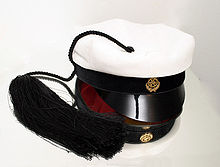
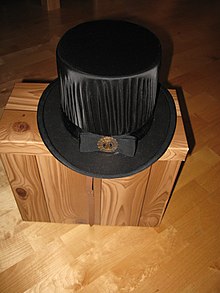
Finland and Sweden have similar traditions when it comes to academic clothing. For important academic ceremonies white tie is usually worn, however, often with traditional headwear and gowns. Gowns are not generally used except by the rector as a symbol of office, if anyone.
The regular student cap (Finnish: ylioppilaslakki, Swedish: studentmössa) usually has a white velvet crown, a black band and a black beak. The cap can be worn by anyone who has passed the matriculation examination and is acceptable wear for both formal and informal academic celebrations. Technology students wear a special kind of student cap called a teekkarilakki (Finnish) or teknologmössa (Swedish). It is similar to the traditional student cap, but features a tuft and a distinctive cockade to show which university the wearer is attending. Technology students generally wear their caps more frequently, and thus the tuft often symbolizes university engineering students. Although universities have different rules regarding the use of the cap, caps are generally not awarded to students until the completion of the first year of studies. The technology student's hat may also be seen on informal occasions, being worn with the student overall at many universities.
In both countries many universities have doctoral hats for persons who have completed a PhD or similar degree. These usually resemble top hats and must be worn with white tie. Like other hats, they are not generally worn indoors, but they may be presented on a table. Events where the hat and white tie are worn include thesis defences, post-doctoral parties, ceremonial conferments of degrees, opening ceremonies and other formal ceremonies related to the university.[55] At some universities, a doctoral ring is awarded together with the hat. In the Ingmar Bergman film Wild Strawberries, one scene shows the conferral of a Jubilee doctor degree on the main character at the University of Lund, which includes the presentation of such a hat and ring. At the University of Helsinki a cape and a sword are commonly worn with the doctoral hat. Students of the student organization "Limes" may also be seen wearing a black cape.[56]
Thailand[]
In Thailand, there are five different styles of academic dress: (1) traditional Thai, (2) traditional American, (3) French (Paris), (4) modified American, and (5) modified British.
Some universities prefer a traditional robe originated in the royal court, known as suea khrui. Traditionally, the robe is a one-piece open-fronted garment made with a mesh, faced and bordered with a velvet or felt band. Since the conception of Chulalongkorn University, the traditional suea khrui was adopted for their graduates. Influenced by the colour of gowns used at Oxford, bachelor's' and master's gown are faced and bordered with a black felt band. Meanwhile, a scarlet felt band is reserved for doctors. There are patterns upon the felt band to denote different degrees and faculties.[57] Other universities that utilise the traditional robe might, instead of a mesh, use another kind of fabric for their dress.
Other universities in Thailand that use a traditional robe include
- Mae Fah Luang University, Chiang Rai;[58]
- Sukhothai Thammathirat Open University, Nonthaburi;[59]
- Khon Kaen University;[60]
- Naresuan University, Phitsanulok;[61]
- Mahachulalongkorn Buddhist University, Phra Nakhon Si Ayutthaya;[62]
- Mahamakut Buddhist University, Nakhon Pathom;[63]
- All King Mongkut's Universities of Technology;
- Most Rajabhat Universities and all Rajamangala universities of technology.
As a note, Mahachulalongkorn and Mahamakut Buddhist universities do not prescribe an academic dress for monks, nuns and clergymen. It is also customary that monks and ministers of religion do not wear a dress, when they are being admitted to the degree at other Thai universities.
Other universities employs academic dress of the modified American pattern, with the exception at Thammasat University and Kasetsart University. Thammasat University employs a plain black gown with different epitoge, a strip of cloth worn over the left shoulder, for distinct degrees. The number of fur bands upon the epitoge indicates the degree (i.e. 3 for doctors, 2 for masters and 1 for bachelors). The hat is not worn.[64] Kasetsart University, on the other hand, retains the original American academic dress style.[65] For bachelors, the dress comprises a plain sleeve gown with a coloured cord around the neck. This is different from many American universities, at which a scarf is used instead of a cord. Masters' gown exactly follows the American design. The sleeve is sewn shut at the end, with a slit to free the arm. Doctors' gown also follows the American tradition. The sleeve has three velvet bars to denote the seniority. The hat is included.
Since most Thai universities do not fully understand the original American tradition, they usually use an American doctoral gown for their doctoral degree. By reducing the number of velvet bars on the sleeve, it is possible to get gowns for masters (2 bars) and bachelors (1 bar or none). Notable examples of this deviation include Ramkhamhaeng University, Burapha University, Mahidol University and the University of Phayao. Some universities even incorporate the hood into a pattern on the gown, including Suranaree University of Technology and Walailak University. This eliminates the need of additional hood.
Prince of Songkhla University uses a gown which is heavily deviated from the original British style. Gowns for bachelors and masters are made of black stuff. Doctoral gowns are made from scarlet cloth. Instead of being open-fronted like ones in the United Kingdom and Australia, all gowns are close-fronted, probably due to the robemakers. The neckband is curved instead of being a chevron. Silpakorn University mixes a modified American gown (i.e. a close-fronted black gown with different number of bars on the sleeve) with an altered version of Oxford simple hood.[66]
Tunisia[]
In Tunisia, University of Ez-Zitouna graduates wear an academic gown. Doctoral graduates in Islamic Sciences wear a jebba.
In other Tunisian universities, Like the Medicine university, Doctoral graduates wear an academic dress.

United Kingdom and Ireland[]


There is a distinction between different types of academical dress. Most recently, gowns, hoods and caps are categorised into their shape and patterns by the Groves classification system, which is based on Nicholas Groves' document, Hood and Gown Patterns.[67] This lists the various styles or patterns of academic dress and assigns them a code or a Groves Classification Number. For example, the Cambridge BA style gown is designated [b2] and a hood in the Cambridge full-shape is designated [f1], etc. Because the universities are free to design their own academicals using a wide range of available gown, hood and cap patterns, colours and materials at their and the robemaker's disposal, the academicals of two given universities rarely clash with each other.
The Burgon Society was founded in 2000 to promote the study of academic dress.[68] Its publications and activities examine the history and current use of academic dress and in 2011 it published the third edition of Shaw's reference book on British and Irish academical dress.[69] The Society hosts a conference each spring at which recent research is presented.[70]
The modern gown is derived from the roba worn under the cappa clausa, a garment resembling a long black cape. In early medieval times, all students at the universities were in at least minor orders, and were required to wear the cappa or other clerical dress, and restricted to clothes of black or other dark colour. The gowns most commonly worn, that of the clerical type gowns of Bachelor's degrees (BA and BS) and Master's degrees (MA and MS), are substantially the same throughout the English-speaking world. All are traditionally made of black cloth, (although occasionally the gown is dyed in one of the university's colours) and the material at the back of the gown is gathered into a yoke. The Bachelor's gown has bell-shaped sleeves, while the Master's gown has long sleeves closed at the end, with the arm passing through a slit above the elbow.[71]
There are two distinctive shapes used in the UK for doctor's gowns; the Oxford doctor's shape and the Cambridge doctor's shape. The former has bell-shaped sleeves, the latter has long open sleeves. Another rarer form is the Cambridge Doctor of Music dress gown which is a pattern between the two. The other form of doctor's gown is the undress gown. This is a black gown worn for less formal occasions such as lectures. This type of gown is rarely seen or worn nowadays as many wear the dress gown instead; however, the undress gown still plays a part in the older universities where academic dress is usually worn.
Undergraduates at many older universities also wear gowns;[72] the most common essentially a smaller knee-length version of the Bachelor's gown, or the Oxford Commoners gown which is a sleeveless lay type gown and has two streamers at the back at Oxford.[73] At Cambridge, most colleges have their own distinctive design of gown.[74] Undergraduates at St Andrews, with the exception of theology students, commonly wear scarlet woollen gowns with velvet collars.[75] Undergraduate gowns are seldom worn (even in institutions that prescribe them) nowadays except in the older universities.
Another form of dress, now rarely seen, is the habit, which is worn over a black gown. Only Oxford, Cambridge, Durham and Newcastle use habits and mainly reserve their use for very formal ceremonial occasions and to a specific group of academics or officials.
The hood was originally a functional garment, worn to shield the head from the elements. In the English tradition, it has developed to an often bright and decorative garment worn only on special occasions. Hoods comprise two basic patterns: full shape or simple shape. The traditional full-shape hood consists of a cape, cowl, and liripipe, as is used at Cambridge. At Oxford, the bachelors' and masters' hoods use simple hoods that have lost their cape and retain only the cowl and liripipe.[76] The colour and lining of hoods in academic dress represents the rank and/or faculty of the wearer.[77] In many Commonwealth universities bachelors wear hoods edged or lined with white rabbit fur, while masters wear hoods lined with coloured silk (originally ermine or other expensive fur). Doctors' hoods are normally made of scarlet cloth and lined with coloured silk.[78] Faculty colours were introduced by the University of London and many universities followed suit.[79]
The academic cap or square, commonly known as the mortarboard, has come to be symbolic of academia. In some universities it can be worn by graduates and undergraduates alike. It is a flat square hat with a tassel suspended from a button in the top centre of the board. The mortarboard may also be referred to as a trencher cap (or simply trencher). The tassel is composed of a cluster of silk threads which are wrapped together with a cord which is attached to the button affixed to the centre of the headpiece. The loose strands are allowed to fall freely over the board edge, typically falling over the left front side of the cap. Often the strands are plaited together to form a cord with the end threads left untied. In many universities, holders of doctorates wear a soft-crowned, round-brimmed headpiece known as a Tudor bonnet or tam, rather than a trencher. Other types of hats used, especially in some universities in the UK, are the (mostly at Scottish universities), the Bishop Andrewes cap (a reinvention of the ancient form of the mortarboard, worn by Cambridge Doctors of Divinity DD's) and the pileus (at Sussex). In some universities, such as Oxford, women may wear an Oxford ladies' cap.[80]
Officers of the universities generally wear distinctive and more elaborate dress. The Chancellor and the Vice-Chancellor may wear a black damask lay type gown (sometimes with a long train) trimmed with gold or silver lace and frogs. They wear a velvet mortarboard, similarly trimmed with gold braid and tassel. Other than this gown, they may have other distinct forms of dress, such as the scarlet cappa clausa or cope worn in certain circumstances by the Vice-Chancellor of Cambridge or his/her deputy and by higher doctors presenting candidates for degrees, which was once worn by Doctors of Divinity.[81] In the past, Chancellors may also wear full court dress with breeches and court shoes like that of the Lord Chancellor of Great Britain.
At degree ceremonies, graduands often dress in the academic dress of the degree they are about to be admitted to prior to the actual graduation ceremony. This is not the case at several of the older universities in the UK, most notably, Oxford, Cambridge and St Andrews which have their own distinct traditions.
In addition to universities and colleges, a number of British professional bodies, such as the Institute of Biology and the Institute of Physics grant academic dress to their members.[82]
United States[]

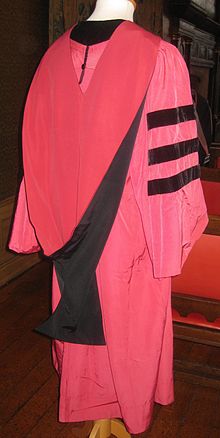

Academic regalia in the United States has been influenced by the academic dress traditions of Europe. There is an Inter-Collegiate code which sets out a detailed uniform scheme of academic regalia followed by most, though some institutions do not adhere to it entirely, and fewer still ignore it.
The practice of wearing academic regalia in the United States dates to the Colonial Colleges period, and was heavily influenced by European practices and styles.[83] Students of most colonial colleges were required to wear the "college habit" at most times – a practice that lasted until the eve of the American Civil War in many institutions of higher learning.[84] In some rare instances the practice has persisted, such as at Sewanee, where members of the student honor society, along with most professors, continue to wear the gown to class.[85] After the Civil War, academic regalia was generally only worn at ceremonies or when representing the institution.[84] There was not, however, any standardization among the meanings behind the various costumes. In 1893, an Intercollegiate Commission made up of representatives from leading institutions and chaired by President of Columbia Seth Low was created, to establish an acceptable system of academic dress. The commission met at Columbia University in 1895 and adopted a code of academic regalia, which prescribed the cut and style and materials of the gowns, as well as determined the colors which were to represent the different fields of learning.[86] These rules were soon adopted by Columbia's peer institutions, including Harvard, Yale, and Princeton.[87] In 1932 the American Council on Education (ACE) authorized the appointment of a committee to determine whether revision and completion of the academic code adopted by the conference of the colleges and universities in 1895 is desirable at this time, and, if so, to draft a revised code and present a plan for submitting the code to the consideration of the institutional members of the council.
The committee reviewed the situation and approved a code for academic costumes that has been in effect since that year. A Committee on Academic Costumes and Ceremonies, appointed by the American Council on Education in 1959, again reviewed the academic dress code and made several changes.[83]
Although academic dress is now rarely worn outside commencement ceremonies or other academic rituals such as encaenia in the U.S. graduation ceremonies have gained popularity and have expanded from high school graduations to middle school, elementary school and kindergarten graduation ceremonies.[88]
Bachelors' and masters' gowns in the United States are similar to their counterparts in the United Kingdom, though bachelor's gowns are now designed to be worn closed, and all are at least mid-calf length to ankle-length.[89] The masters' gown sleeve is oblong and, though the base of the sleeve hangs down in the typical manner, it is square cut at the rear part of the oblong shape. The front part has an arc cut away, and there is a slit for the wrist opening, but the rest of the arc is closed. The shape is evocative of the square-cut liripipe incorporated into many academic hoods (see, below). The master's gown is designed to be worn open or closed.[89]
Doctoral robes are typically black, although some schools use robes in the school's colours.[89] The Code calls for the outside shell of the hood (see, below) to remain black in that case, however. In general, doctoral gowns are similar to the gowns worn by bachelor's graduates, with the addition of three velvet bands on the sleeves and velvet facing running down the front of the gown. The Code calls for the gown trim to be either black or the colour designated for the field of study in which the doctorate was earned (see Inter-Collegiate colors). However, in the case of the degree of Doctor of Philosophy (PhD), although it is awarded for study in any number of fields, the dark blue velvet of philosophy is always used regardless of the particular field studied. For example, if not choosing black trim, a PhD in theology would wear velvet gown trim in dark blue, while a Doctor of Theology (Th.D.) would wear scarlet trim, if not choosing black. The robes have full sleeves, instead of the bell sleeves of the bachelor's gown. Some gowns expose a necktie or cravat when closed, while others take an almost cape-like form. It is designed to be worn open or closed in the front.[89]
The Code calls for the shell material of the hood to match the robe, and for the colour to be black regardless of the colour of the robe being worn.[90] The interior lining – generally silk – displays the colours of the institution from which the wearer received the degree, in a pattern prescribed by it (usually, if more than one colour is used, chevrons or equal divisions).[91] The opening of the hood is trimmed in velvet or velveteen.[92] In most American colleges and universities, the colour of the velvet hood trimming is distinctive of the academic field – or as closely related as possible – to which the degree earned pertains (see Inter-Collegiate colors).[93] Many institutions, particularly larger ones, have dispensed with the bachelor's hood at commencement ceremonies altogether, though a graduate is still entitled to wear one once the degree is conferred.[94]
Headwear is an important component of cap-and-gown, and the academic costume is not complete without it. The headwear will vary with the level of academic achievement and, to some extent, on the individual academic institution's specifications. For caps, the mortarboard is recommended in the Code, and the material required to match the gown.[95] The exception—velvet—is reserved for the doctor's degree only, seen in the form of a multiple-sided (4, 6, or 8) tam, but the four-sided mortarboard-shaped tam in velvet is what the Code seems to recommend here.[95] The only colour called for is black, in all cases.[95] The tassel worn on the mortarboard or a tam seems to provide, by tradition, the greatest opportunity for latitude in American academic dress. It has been black, or represented the university's colours, or the colours of the specific college, or the discipline. The tassel has also been used to indicate membership in national honour societies or other awards. There is at some colleges and universities a practice of moving the tassel from one side to the other on graduating, but this is a modern innovation that would be impractical out of doors due to the vagaries of the wind. For doctoral and masters students, the tassel commonly begins and remains on the left.[96]
The colours allocated to the various fields of learning have been largely standardized in the United States by the Intercollegiate Bureau of Academic Costume, and accepted by the American Council on Education in its Academic Costume Code.[91] Some of the more common colours seen are that liberal arts is represented by white, science by golden yellow, medicine by green, law by purple, theology by scarlet, and philosophy (including all PhD degrees) by dark blue. A distinction is made in the code, which calls for a graduate to display the colour of the subject of the degree obtained, not the degree itself.[92] For example, if a graduate is awarded a Bachelor of Arts (BA) degree specifically in business the trimming should be drab, representing commerce/accountancy/business, rather than white, representing the broader arts/letters/humanities; the same method is true of master's degrees and doctorates. However, in 1986, the American Council on Education updated the Code and added the following sentence clarifying the use of the colour dark blue for the Doctor of Philosophy degree, which is awarded in any number of fields: "In the case of the Doctor of Philosophy (PhD) degree, the dark blue colour is used to represent the mastery of the discipline of learning and scholarship in any field that is attested to by the awarding of the degree, and it is not intended to represent the field of philosophy."[92]
A number of other items such as cords, stoles, aiguillettes, etc. representing various academic achievements or other honours are also worn at the discretion of some degree-granting institutions. Technically, however, the ACE code does not allow their use on or over academic regalia.
Pontifical universities[]
Academic dress for pontifical universities tends to vary by the host country. Traditionally, for doctors of a pontifical university or faculty "the principal mark of a Doctor's dignity is the four horned biretta."[97] Under the old Code of Canon Law, in commencement ceremonies and other academic settings, doctors from pontifical faculties and universities had a canonical right to wear the doctoral biretta, as stated in can. 1378, and explained in commentary 262 of the Commentarium Codicis Iuris Canonici as follows:
262. Doctoratus ac Scentiae effectus canonici sic recensentur can. 1378...doctoribus seu gradum academicum in una ex quatuor supradictis facultatibus <<vide 261: philosophia, theologia, ius canonicum, Sacra Scriptura>> supremum obtinentibus, rite creatis, seu promotis regulariter post examen, iuxta « statuta a Sede Apostolica probata » (can. 1376, § 2) saltem quoad usum validum « facultatis ab eadem Aplca. Sede concessae » (can. 1377, § 1), deferendi, extra sacras functiones, (quarum nomine ad hunc eflectum non-venit ex usu sacra praedicatio), nisi aliunde amplietur eis hoc ius quoad a) annulum etiam cum gemma « ipsis a iure huius canonis concessum » (can. 136, § 2), b) et biretum doctorale, (idest: cum quatuor apicibus) utpote insigne huius gradus ac diverso colore ornatum pro Facultate.:[98][clarification needed]
There is no equivalent canon in the current Code of Canon Law promulgated in 1983, but the tradition remains.
The Sartoria Gammerelli as of August 2013 offers, in line with the updated stipulations of the Pontifical Gregorian University, birettas lined with the following assorted piping and tufts depending on which faculty one is graduated from: Green for Canon Law, Red for Sacred Theology, Blue for Philosophy, and Orange for Social Sciences. Three-horned birettas are to be used by Licentiates, four-horned for Doctors.
Academic dress for the Pontifical University of Saint Thomas Aquinas, Angelicum graduates consists of a black toga or academic gown with trim to follow the color of the faculty, and an academic ring. For the doctoral degree a four corned biretta is to be worn, and for the Licentiate degree a three corned biretta is to be worn. See:Academic regalia of the Pontifical University of St. Thomas Aquinas. The 'traditional' biretta at the Pontifical University of Saint Thomas Aquinas, Angelicum, is white, to correspond to the white Dominican habit.[99] Also, the academic senate of the Angelicum in its May 2011 meeting indicated that the black biretta may be used with trim and pom in the color of the particular faculty.[100]
A three-peaked black biretta with appropriately colored piping may be similarly used by those receiving the licentiate degree (S.T.L., Ph.L.).
See also[]
- Academic procession
- Academic stole
- Burgon Society
- Chinese academic dress
- Ede & Ravenscroft
- Encaenia
- Graduation
- Groves classification system
- The Central Institute London
Academic dress details for the following universities are available via these links:
Canada
United Kingdom and Ireland
- Academic dress of the University of Bristol
- Academic dress of the University of Cambridge
- Academic dress of Durham University
- Academic dress of the University of Edinburgh
- Academic dress of the University of Exeter
- Academic dress of the University of Hertfordshire
- Academic dress of Imperial College London
- Academic dress of the University of Kent
- Academic dress of King's College London
- Academic dress of the University of Leeds
- Academic dress of Liverpool John Moores University
- Academic dress of the University of London
- Academic dress of the University of Manchester
- Academic dress of the University of Nottingham
- Academic dress of the University of Oxford
- Academic dress of the University of St Andrews
- Academic dress of the University of Wales
- Academic dress of the University of Wales, Lampeter
- Academic dress of the University of Warwick
- Academic dress of the University of Dublin
- Undergraduate gowns in Scotland
- Lambeth degree academic dress protocol
Others
- Academic dress of La Trobe University
- Academic dress of the Royal Melbourne Institute of Technology
- Academic dress of Columbia University
- Academic dress of Harvard University
- Academic dress of Stanford University
- Academic dress of universities in Queensland, Australia
- Academic dress of University of Melbourne
Bibliography[]
Books
- Christianson, Bruce (2006), "Academic Dress in the University of Hertfordshire". Hertfordshire, England: University of Hertfordshire. ISBN 190531339X
- Fowler, J. T. (1904), Durham University: earlier foundations and present colleges. London: F. E. Robinson & Co.
- Goff, Philip (1999), University of London Academic Dress. London: University of London Press. ISBN 0-7187-1608-6
- Shaw, George W. (1966, 1995), Academical Dress of British and Irish Universities. Chichlester: Philmore & Co. Ltd. ISBN 0-85033-974-X
- Groves, Nicholas (2011), Shaw's Academical Dress of Great Britain and Ireland, 3rd ed. London: Burgon Society.
- Groves, Nicholas (2002, 2003, 2008, 2010), Key to the Identification of Academic Hoods of the British Isles. London: Burgon Society.
- Groves, Nicholas; Kersey, John (2002), Academical Dress of Music Colleges and Societies of Musicians in the United Kingdom. Norfolk: Burgon Society. ISBN 0-9544110-0-5
- Hargreaves-Mawdsley, W.N. (1963), A History of Academical Dress in Europe. Oxford: Clarendon Press.
- Venables, J. (2009), Academic Dress of the University of Oxford, 9th ed. Oxford: Shepherd & Woodward. ISBN 0-9521630-0-4
- Cox, Noel, Academical Dress in New Zealand: A Study (V.D.M. Verlag Dr. Müller Aktiengesellschaft & Co. K.G., Saarbrücken, 2010; ISBN 978-3-639-29927-4)
Journals
- Kerr, Alex (ed.) et al. (2004), The Burgon Society Annual 2003.
- Kerr, Alex (ed.) et al. (2005), The Burgon Society Annual 2004. ISBN 0-9544110-6-4
- Kerr, Alex (ed.) et al. (2006), Transactions of the Burgon Society: Volume 5. ISBN 0-9544110-7-2
- Kerr, Alex (ed.) et al. (2008), Transactions of the Burgon Society: Volume 6. ISBN 0-9544110-8-0
- Kerr, Alex (ed.) et al. (2008), Transactions of the Burgon Society: Volume 7. ISBN 978-0-9544110-5-3
- Kerr, Alex (ed.) et al. (2009), Transactions of the Burgon Society: Volume 8. ISBN 978-0-9561272-1-1
- Kerr, Alex (ed.) et al. (2012), Transactions of the Burgon Society: Volume 10. ISBN 978-0-9561272-6-6
- Powell, Michael (ed.) et al. (2002), The Burgon Society Annual 2001.
- Powell, Michael (ed.) et al. (2003), The Burgon Society Annual 2002.
- Wolgast, Stephen L., Kerr, Alex (eds) et al. (2011), Transactions of the Burgon Society: Volume 9 – Special North American issue. ISBN 978-0-9561272-4-2
- Wolgast, Stephen L. (ed.) et al. (2012), Transactions of the Burgon Society: Volume 11.
- Wolgast, Stephen L. (ed.) et al. (2013), Transactions of the Burgon Society: Volume 12.
- Wolgast, Stephen L. (ed.) et al. (2014), Transactions of the Burgon Society: Volume 13.
Electronic
- Sullivan, Eugene (ed.) An Academic Costume Code and An Academic Ceremony Guide, American Council on Education. Reprinted with permission from American Universities and Colleges, 15th Edition (1997). Walter de Gruyter, Inc.
- Smagorinsky, Margaret. The REGALIA of Princeton University: Pomp, Circumstance, and Accountrements of Academia. The Trustees of Princeton University (Printed by Office of Printing and Mailing), 1994. Accessed 26 September 2008.
Further reading[]
- American Council on Education staff (1997). American Universities and Colleges, 15th Edition. Walter de Gruyter, Inc. ISBN 0-275-98745-0
- Belting, Natalia Maree (1956), The History of Caps and Gowns, New York : Collegiate Cap & Gown Co. via Internet Archive
- Franklyn, C.A.H. (1970), Academical Dress from the Middle Ages to the Present Day Including Lambeth Degrees. Lewes: WE Baxter.
- Haycraft, F.W. (1948), 4th ed. rev. Stringer, E.W Scobie, The Degrees and Hoods of the World's Universities and Colleges. Cheshunt Press.
- Rashdall, H. (1895, 1936), The Universities of Europe in the Middle Ages. Oxford: Claredon Press.
- Rogers, F.R.S., Franklyn, C.A.H., Shaw, G.W., Boyd, H.A. (1972), The Degrees and Hoods of the World's Universities and Colleges. Lewes: WE Baxter.
- Smith, H.H., Sheard, K. (1970), Academic Dress and Insignia of the World. Cape Town: A.A. Balkema.
- Wood, T.W. (1882), The Degrees, Gowns and Hoods of the British, Colonial, Indian and American Universities and Colleges. London: Thomas Pratt & Sons.
References[]
- ^ Shaw (1995), p. 3
- ^ "Cox, N. (2000). Academical dress in New Zealand". Archived from the original on 14 November 2015. Retrieved 12 March 2016.
- ^ e.g. Burgon Society: Robes Archived 23 September 2015 at the Wayback Machine
- ^ "History and Archives of the American College of Surgeons; Highlight of the Month October 10, 2005; The Clinical Congress: Then and Now, accessed 01/29/2008". Facs.org. Archived from the original on 19 May 2011. Retrieved 28 April 2010.
- ^ "Goff, pp. 13–14". Phildress.co.uk. Archived from the original on 15 May 2011. Retrieved 28 April 2010.
- ^ n.wood@sheffield.ac.uk. "University of Sheffield: What should I wear?". Shef.ac.uk. Archived from the original on 5 April 2010. Retrieved 28 April 2010.
- ^ Sullivan. The Academic Costume Code, Gowns, Material
- ^ Sullivan. The Academic Costume Code, Caps, Material
- ^ American English uses 'rented', British English uses 'hired'.
- ^ An Ede & Ravenscroft Oxford MA hood made of pure Ottoman silk will cost around £347. Source: http://www.gownhire.co.uk (21 September 2007)
- ^ The cost difference between artificial and real fur can be as much as a few hundred pounds.
- ^ Ede & Ravenscroft: Oxford DMus undress and full dress academic dress costs £2910 (undress gown: £181, hood: £409, rigid mortarboard: £80, full dress gown: £2117, velvet bonnet: £123). Information retrieved 18 May 2007.
- ^ Hired hoods are usually partially lined instead of fully lined when the regulations specify a fully lined hood. However, in some cases, a hood that is specified as fully lined in the regulations, in practice, is part-lined to save on materials. This is especially the case for Glasgow full-shape hoods [f9] as they are large and most of the lining may not be seen when worn.
- ^ "Academic Gowns".
- ^ Gibson, William (2004). The Regulation of Undergraduate Dress at Oxford and Cambridge, 1660–1832. Burgon Society Annual.
- ^ Hargreaves-Mawdsley, W.N. (1963). A History of Academical Dress in Europe until the End of the Eighteenth Century. Oxford: Clarendon Press.
- ^ Armagost, Robert (2009). University Uniforms: The Standardization of Academic Dress in the United States. Transactions of the Burgon Society, 9, p. 140.
- ^ "Man trägt wieder Talar" (in German). Westfälische Nachrichten. 11 November 2012. Retrieved 11 September 2016.
- ^ Jump up to: a b "Amtstracht des Rektors". University of Marburg. Retrieved 11 September 2016.
- ^ "Die neue Amtskette des Rektors unserer Universität" (in German). Technische Universität Dresden. 16 March 2010. Retrieved 11 September 2016.
- ^ "Die beiden Marburger Universitätsszepter" (in German). University of Marburg. Retrieved 11 September 2016.
- ^ "Famous photo of students in 1967 revolting in Hamburg in front of fully dressed scholars". Spiegel.de. 13 July 2005. Retrieved 28 April 2010.
- ^ "Feierliche Immatrikulation an der Universität Rostock" (in German). Rostock Heute. 17 October 2010. Retrieved 17 September 2016.
- ^ "Schöner feiern mit Kette und Talar?" (in German). Tagesspiegel. 29 June 2003. Retrieved 17 September 2016.
- ^ "Von Tradition und Moderne: Friedrich-Schiller-Universität Jena begrüßt neue Studierende mit feierlicher Immatrikulation" (in German). Thüringen Reporter. Archived from the original on 17 September 2016. Retrieved 17 September 2016.
- ^ "Tradition an der Martin-Luther-Universität Halle: Talare als Zeichen der Freiheit" (in German). Mitteldeutsche Zeitung. 2 November 2014. Retrieved 17 September 2016.
- ^ "Akademische Kleidung" (in German). University of Heidelberg. Retrieved 17 September 2016.
- ^ "Pompöse Abschlussfeier: Die Rückkehr der Talare" (in German). Spiegel Online. 13 July 2005.
- ^ "Sie können stolz auf sich sein!" (in German). TU Chemnitz. 25 April 2015.
- ^ "Hüte & Schärpen" (in German). RWTH Aachen. Archived from the original on 21 September 2016. Retrieved 6 September 2016.
- ^ "Historische Insignien der Philipps-Universität" (in German). University of Marburg. Retrieved 6 September 2016.
- ^ "Prosaisch bis pompös: Absolventenfeiern und Abschiedsrituale – Aktuelles aus der Goethe-Universität Frankfurt" (in German). Goethe University Frankfurt. Retrieved 6 September 2016.
- ^ "SESI VI | Foto Liputan | Wisuda Agustus 2017 | Foto Wisuda Unpad". gallery.unpad.ac.id. Retrieved 26 August 2017.
- ^ "Archived copy". Archived from the original on 19 October 2013. Retrieved 18 October 2013.CS1 maint: archived copy as title (link)
- ^ http://bologna.repubblica.it/images/2010/12/17/123141060-65907856-b255-4cd7-aa52-c8c7a8309c5d.jpg
- ^ "Archived copy". Archived from the original on 19 October 2013. Retrieved 18 October 2013.CS1 maint: archived copy as title (link)
- ^ http://www-5.unipv.it/alumni/images/GIORNATAdelLAUREATO_banner.jpg[permanent dead link]
- ^ Jump up to: a b "Archived copy". Archived from the original on 19 October 2013. Retrieved 18 October 2013.CS1 maint: archived copy as title (link)
- ^ "Archived copy". Archived from the original on 19 October 2013. Retrieved 18 October 2013.CS1 maint: archived copy as title (link)
- ^ "Archived copy". Archived from the original on 19 October 2013. Retrieved 18 October 2013.CS1 maint: archived copy as title (link)
- ^ http://www.unipi.it/ateneo/comunica/cerimonie/inaugura/anno_accademico2003.htm_asc001.jpg
- ^ http://farm9.staticflickr.com/8364/8269201093_b8f863d3c8_h.jpg
- ^ http://www.lanazione.it/data/images/gallery/2012/46488/21.JPG
- ^ "Archived copy". Archived from the original on 19 October 2013. Retrieved 18 October 2013.CS1 maint: archived copy as title (link)
- ^ QuestIT s.r.l. "Archivio Corriere della Sera".
- ^ Jump up to: a b "Unibo lauree giugno 2012: con toga in piazza Maggiore". BolognaToday.
- ^ "Via Sarfatti 25 – Toga e tocco per i nuovi laureati".
- ^ "Archived copy". Archived from the original on 22 October 2013. Retrieved 18 October 2013.CS1 maint: archived copy as title (link)
- ^ "..:::: Unisinforma ::::." Archived from the original on 19 October 2013.
- ^ "Come scegliere i colori giusti per la laurea". Come Fare. Archived from the original on 18 October 2013. Retrieved 18 October 2013.
- ^ Jump up to: a b c "What to wear to graduation – The University of Auckland". Auckland.ac.nz. Retrieved 15 June 2013.
- ^ "What to wear to graduation – The University of Auckland". Auckland.ac.nz. Retrieved 15 June 2013.
- ^ "Alumni & Friends – University of Otago – University of Otago". Alumni.otago.ac.nz. Retrieved 15 June 2013.
- ^ "UP Sablay". Retrieved 21 August 2010.
- ^ Sirkka Lassila, 1990. Uusi käytöksen kultainen kirja. Suuri Suomalainen Kirjakerho, Helsinki. Page 518.
- ^ "Tiedostot | Viralliset asiat". Limes.fi. Archived from the original on 14 September 2012. Retrieved 28 April 2010.
- ^ "University Calendar on Academic Dress, 2010" (PDF). Chulalongkorn University. Royal Thai Government.
- ^ "University Ordinance on the Official and Academic Dress, 2003" (PDF). Mae Fah Luang University. Royal Thai Government Gazette. Retrieved 13 July 2021.
- ^ "University Calendar". Sukhothai Thammathirat Open University. STOU. Retrieved 13 July 2021.
- ^ "Khon Kaen University's Ordinance on Academic and Official Dress" (PDF). Khon Kaen University. Royal Thai Government. Retrieved 13 July 2021.
- ^ "By-law on Academic Dress, Academic Badge and Degrees of Naresuan University" (PDF). Naresuan University. Royal Thai Government.
- ^ [Mahachulalongkornrajavidyalaya "University Ordinance on Academic Dress, Badge and Official Dress, 2015"] Check
|url=value (help). Mahachulalongkornrajavidyalaya University. Mahachulalongkornrajavidyalaya. Retrieved 14 July 2021. - ^ "Graduate Manual for the Graduation Ceremony" (PDF). Mahamakut Buddhist University. Mahamakut Buddhist University.
- ^ "Ordinance on the Academic Dress and Academic Badge" (PDF). Thammasat University. Royal Thai Government. Retrieved 13 July 2021.
- ^ "By-law on the Academic Dress and Degrees, Kasetsart University" (PDF). Kasetsart University. Royal Thai Government. Retrieved 13 July 2021.
- ^ Graduation Ceremony Manual, Silpakorn University
- ^ The Burgon Society: The Design of Academical Dress Archived 23 February 2009 at the Wayback Machine (6 May 2007) Classification of Styles
- ^ Burgon Society: Introduction Archived 22 May 2013 at the Wayback Machine (2 November 2008)
- ^ Groves, Nicholas. "Shaw's Academical Dress of Great Britain and Ireland", London: Burgon Society, 2011.
- ^ "Meeting of the Burgon Society." http://www.burgon.org.uk/society/meetings.php Archived 17 October 2013 at the Wayback Machine
- ^ Shaw (1995); pp. 4–7
- ^ Hargreaves-Mawdsley, pp. 91–101, 128–135, 146, 148–149
- ^ "Shepherd & Woodward: Oxford University student gowns". Shepherdandwoodward.co.uk. Retrieved 28 April 2010.
- ^ "CU Cap & Gown Society: Gown-spotter's guide". Srcf.ucam.org. Archived from the original on 5 March 2009. Retrieved 28 April 2010.
- ^ http://www.st-andrews.ac.uk/capod/staff/resourcesfornewstaff/universityintroduction/studentsatstandrews/universityofstandrewstraditions/traditionalredgowns/[permanent dead link]
- ^ Burgon Annual 2003 (2004); pp. 18–23
- ^ Groves (2008), Hood Key
- ^ Shaw (1995); p. 8
- ^ Burgon Transactions vol. 5 (2006); pp. 80–89
- ^ Goff; pp.22–23
- ^ Shaw (1966); pp. 94–95
- ^ "Regulations for other Institutions and Societies". Burgon Society. Retrieved 16 August 2017.
- ^ Jump up to: a b Sullivan. The Academic Costume Code, Historical Overview
- ^ Jump up to: a b Smagorinsky. The Regalia of Princeton University: Pomp, Circumstance, and Accoutrements of Academia. Page 5.
- ^ "About – The Order of Gownsmen – Sewanee :: The University of the South". Sewanee.edu. Archived from the original on 29 May 2010. Retrieved 28 April 2010.
- ^ New York Times. "Gowns for College Men; Academic Costumes in American Universities (1896): Plan to Secure a Uniform Practice in the Use of the Caps and Gowns in This Country So that the Degree of the Wearer, the Faculty Under Whom It Was Obtained, and the Institution Conferring It May Be Readily Seen." Sunday, 26 April 1896.
- ^ Columbia Alumni News. Alumni Council of Columbia University. 1920.
- ^ "Kindergarten graduation in the United States". Rhymeuniversity.com. Archived from the original on 10 May 2010. Retrieved 28 April 2010.
- ^ Jump up to: a b c d Sullivan. The Academic Costume Code, Gowns
- ^ Sullivan. The Academic Costume Code, Hoods
- ^ Jump up to: a b Sullivan. The Academic Costume Code, Hoods;Linings
- ^ Jump up to: a b c Sullivan. The Academic Costume Code, Hoods; Trimmings
- ^ Sullivan. The Academic Costume Code, Additional Guidance on Costume
- ^ Sullivan. The Academic Costume Code, Some Permissible Exceptions
- ^ Jump up to: a b c Sullivan. The Academic Costume Code, Caps
- ^ Sullivan. The Academic Costume Code, Wearing the Costume
- ^ John Abel Nainfa, Costume of Prelates of The Catholic Church: According To Roman Etiquette, 164.
- ^ Codex Iuris Canonici, 1917, can. 1378; Commentarium Textus Codicis Iuris Canonici, 1923, comm. 262: Commentarium Codicis Iuris Canonici, 1922, Liber III, Pars IV, Tit. XXII, 262
- ^ papabear. "The New Beginning".
- ^ "Ring, Biretta and Gown for Graduates". Pust.it. 15 June 2011. Archived from the original on 28 July 2013. Retrieved 15 June 2013.
External links[]
| Wikimedia Commons has media related to Academic dress. |
- "Academic Dress" mini portal – A list of internet resources compiled by The New York Times
- Academic Costume Code and Ceremony Guide from American Universities and Colleges, 15th Edition, by Eugene Sullivan.
- Academic dress




